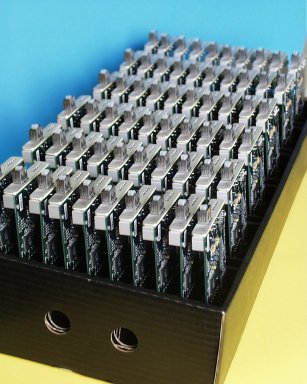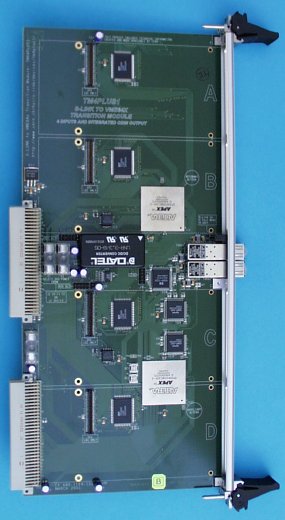

S-LINK News 2001
COMPASS has taken 28 TByte of data over S-LINK
5 November 2001. Compass has finished data taking for 2001. Typically
beam intensities of greater than 2*10^8 muons/spill (design value) were
used. The 25 ns period is now used for systematic studies of the DAQ and
some detectors. The last two weeks of data taking were particularly successful.
All detectors promised in the May meeting of the SPSC were installed and
operational.
The DAQ operated reliably at 17 000 events/spill, 30 kbyte/event. In
total 14 TByte of data were taken with the complete 2001 spectrometer,
while
about the same amount of data was taken earlier this year with an incomplete
spectrometer. Data was taken over 85 CATCH
read-out driver modules connected via ODIN
S-LINKs to COMPASS
Read-out buffers of which several are installed in a PC. Those PCs
in turn are read out over Gigabit Ethernet.
The analysis of the data has started. COMPASS is set for physics in
2002.
Quizz answer: 60 cards for COMPASS
27 August 2001. The picture below presents 60 ODIN cards for the
COMPASS experiment. Mike Deliman from Windriver Systems had the most accurate
answer. He kindly suggested to donate his prize (an S-LINK resque kit)
to physics research. In the meantime COMPASS has received another 36 cards
which will be installed in September.
 Quizz:
what is this? ==>
Quizz:
what is this? ==>
4 July 2001. Tell us what the picture shows (what it is, how many)
and what the stuff will do soon. The person sending in the most accurate
and original answer will receive a free S-LINK resque kit containing: twenty
spacers, fourty 2.5 mm screws and a airspray to clean fibre optics. Answers
should be sent to Erik.van.der.Bij@cern.ch
before July 28, 2001.
CERN Stores: 115 cards ordered in three months time; another 96 for COMPASS
8 June 2001. Since March this year HEP users can buy
all S-LINK equipment directly from the CERN stores. Until now, the
experiments have ordered 80 different cards (links and test tools) from
the Stores, while the Stores has ordered 115 cards from the manufacturing
companies. Apart from those orders, the COMPASS experiment has ordered
96 cards.
Although you can buy now from the Stores, you still should order a
long time in advance. To reduce costs, only one or two cards of each type
will be kept in stock, while the delivery times from the manufacturing
companies may be three months or more. We are in discussion with the companies
about shortening the delivery times.
 ATLAS
Tilecal receives S-LINK VME64x transition module
ATLAS
Tilecal receives S-LINK VME64x transition module
7 June 2001. The University of Geneva built the ATLAS
Liquid Argon read-out driver (ROD) module in VME64x format. This module
will receive the data from the front-end links over a transition module,
a module that plugs in at the back of the crate. The Liquid Argon detector
can use for this either the passive S-LINK
transition module (with two S-LINK inputs and one output), or another
module that has a custom input and one S-LINK output.
With another, active transition module, the ATLAS Tilecal
detector can use the same ROD as the one built for the Liquid Argon detector.
This active transition module, dubbed TM4plus1,
contains FIFO buffers for the four input links and can reformat the incoming
data so that it becomes suitable for the ROD. The output link is an ODIN
link integrated on the board. Three boards have been built and are
sent to the Universidad de Valencia where the Alteras will be programmed.
COMPASS receives batch of 60 ODIN link cards; 36 more to come
7 June 2001. The COMPASS experiment has received a batch of 60 Single
ODIN
link cards (for thirty links) for the
readout system. Those cards are of the 128 MByte/s version. COMPASS
will receive soon another 36 Double ODIN link cards that make up eighteen
160 MB/s links. COMPASS has used in the previous year fourty FCS-LINKs
and now upgrades to the faster and cheaper ODIN links.
ATLAS integration tests of Level-1 and Dataflow successful
19 April 2001. In the three weeks starting from 26 March and ending
on 12 April just before Easter, integration tests of Level-1
and Dataflow have been carried out. The following tests have been performed:
MUCTPI
-> ROS; MUCTPI
-> ROIB;
CPROD -> ROIB
and CPROD -> ROS. Please contact Ralf
Spiwoks for details about the results of the test.
Apart from some problems with reset and flow control as some devices
under test (not the link cards) didn't implement those protocols correctly,
the tests have been succesful. When you design boards that use S-LINK,
you should pay particular attention to the reset protocol and flow control.
It's simple to use, but that in fact may be the reason that during the
design not enough attention is paid to it. If you like, you may contact
Erik
van der Bij who will review the design for you.
 S-LINK
equipment available from CERN Stores catalog
S-LINK
equipment available from CERN Stores catalog 
19 March 2001. If you have a CERN budget code and want to  S-LINK equipment, don't look further. All links, test tools, PCI and PMC
interfaces are now available from the CERN Stores. S-LINK is now as easy
to get as an office chair, inkjet cartridge or a resistor.
S-LINK equipment, don't look further. All links, test tools, PCI and PMC
interfaces are now available from the CERN Stores. S-LINK is now as easy
to get as an office chair, inkjet cartridge or a resistor.
Now it's in the Stores, you can order S-LINK equipment coming from three
different countries in just a single Material Request placed via EDH
. There is no need to pass via the S-LINK team to place your orders or
to send out external orders.This will ease your own tracing of the orders
as well. Ordering via the Stores will liberate time of the S-LINK team
members so they'll have more time to help you in deciding which equipment
you need or to review designs that use S-LINK.
You can consult the list of equipment available
from the CERN Stores, you can go in the Stores
Catalog to group 07.87 or search for common terms like SLINK, ODIN,
SLIDAS, SSP or PCI.
ATLAS LArg ROD sends data to ROB
2 February 2001. The ATLAS Liquid
Argon Read-out Driver has been able to send data over an S-LINK to
a RIO2. This setup is very similar to that what can be used in the final
ATLAS system. The data to the ROD was generated by a SLIDAS
data generator mounted on an S-LINK VME64x
transition module, processed by the ROD and then sent out over an ODIN
Link Source Card that was mounted on the same transition module. Trigger
rates upto 30 KHz could be handled with an event size of 1.2 KByte. Only
the LArg front-end link should be connected to this setup to have a full
slice of the data acquisition system operating.
During the tests the following S-LINK boards have been used:
SLIDAS
(for data generation as no front-end input is available), S2VME64X
transition module (to get the data into the ROD), ODIN
(link). For debugging a SLITEST with a
SLIDAD
(for having a dead-end on the link) and a SLIBOX
(for spying on data sent) have been used.
S-LINK64 extension specification
10 January 2001. S-LINK allows data transmission speeds of up to
160 MByte per second. This is limited by the specification of a 32-bit
wide data channel that may run up to 40 MHz. This speed is a nice match
to gigabit serialisers and optical transceivers that are reasonably cheap
because of the Gigabit Ethernet and Fibre Channel markets. This speed may
not match the requirements of all detectors in future high-energy physics
experiments. The CMS experiment is the first one who may need transmission
speeds of up to 800 MByte per second. As it is logical to extend the S-LINK
specification to a higher speed by going wider and faster, together with
CMS the S-LINK team has written the
S-LINK64 extensions specification.
This S-LINK64 extension specification has to be used in conjunction
with the original S-LINK specification (which has been stable since March
1997). Basically S-LINK64 defines a second connector that carries an additional
32 data lines and increases the maximum clock speed up to 100 MHz. Both
specifications can be found at the EDMS
S-LINK project page.
The CMS Trigger and Data Acquisition Group TriDAS group has
presented already in June 2000 the ideas of using the S-LINK "data
funnel" for the detector. No S-LINK64 link designs are started yet. Attila
Racz from CMS will be the first one to design an S-LINK64 board, but it
will not be before 2002 that boards are available. The S-LINK team has
no plans to develop S-LINK64 links, PCI interfaces or test tools in 2001.
Old S-LINK News
CERN - High Speed Interconnect
- S-LINK
Erik van der Bij - 15 April
2002


 Quizz:
what is this? ==>
Quizz:
what is this? ==> ATLAS
Tilecal receives S-LINK VME64x transition module
ATLAS
Tilecal receives S-LINK VME64x transition module